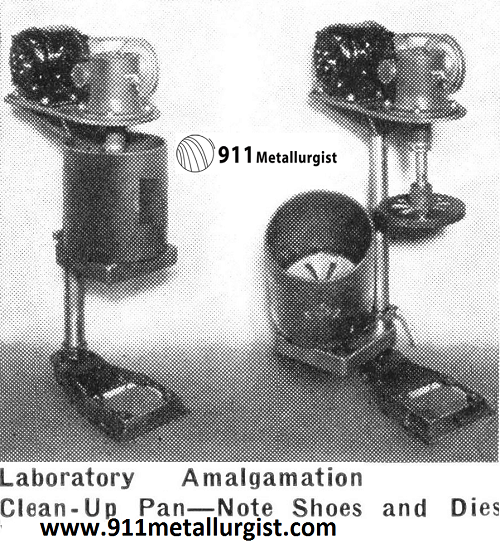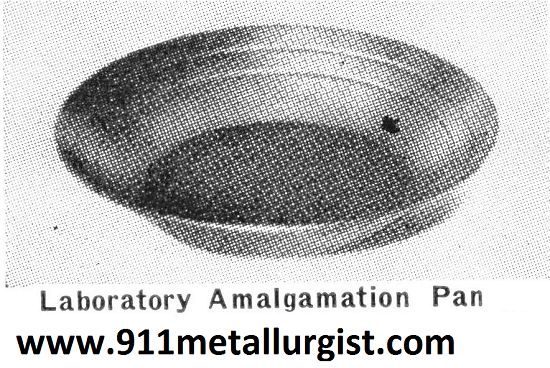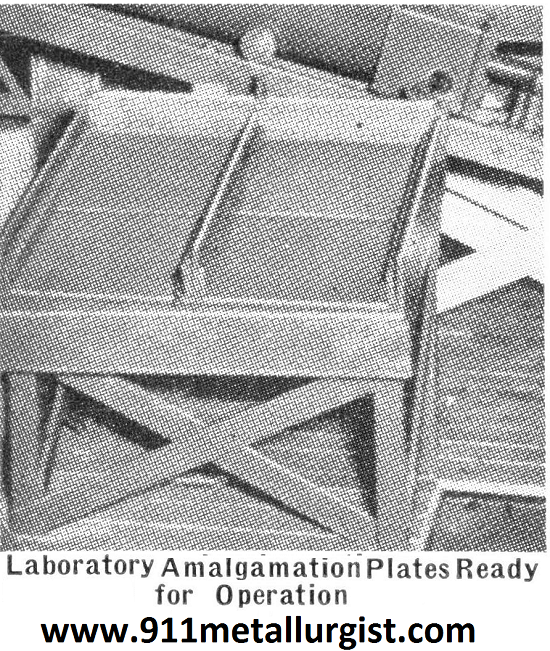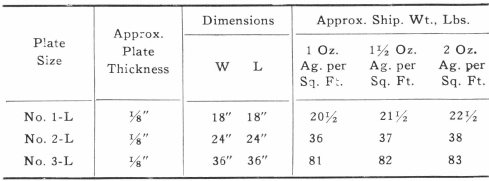Table of Contents
Laboratory Amalgamation Clean-Up Pan
The Laboratory Clean-Up Pan is similar in design to the commercial machine and is used to amalgamate high grade ore or flotation and table concentrates. It can be operated successfully for batch or continuous work.
The unit is mounted on a stand with an adjustable base, so that the charge can be removed easily from the container. The shaft, which has the grinding shoes at the bottom, is driven from the reducer drive and speed can be varied by an adjustable pulley.
Flouring of the mercury is eliminated by the design of the adjustable shoes, which permit mercury to lodge in the amalgam zone underneath the stationary die. This clean-up pan is both a grinding machine and an amalgamator.


Laboratory Hand Amalgamation Pan
Laboratory Hand Amalgamation Pan provides a convenient inexpensive method of testing the annealability of various gold ores to plate amalgamation. Small quantities of a gold ore can thus be tested by hand without resorting to the use or a less expensive copper bottomed steel pan can be supplied. The silver plated pan is recommended as results are more nearly comparable with plate recoveries. However, the copper bottomed pan is an excellent amalgamating unit when coated with mercury.

The pans are made in a standard diameter of 16″ and weigh 2 to 2½ pounds. Various other diameters can be supplied on special orders.
Laboratory Amalgamation Plate
Laboratory Amalgamation Plate is made from the finest, cold rolled, annealed copper plate, approximately 1/8″ thick. Various sizes of plates are furnished with one, one and one-half, or two ounces of silver plating per square foot. Heavier plating is apt to peel, and is not recommended.

Standard sizes of laboratory plates are shown in the following table. These should be specified wherever possible as odd sizes necessitate extra cutting and a 10% increase in price. All plates are carefully wrapped in blankets and then boxed to prevent damage in shipment. Shipping weight is approximately nine pounds per square foot.

Laboratory Amalgamation Units
Laboratory Equipment includes a number of units which may be used for laboratory amalgamation testwork on a scale ranging from the smallest batch work to continuous testing. Units available afford the means for various types of amalgamation treatment to correspond with the commercial process to be used. Two general types of amalgamation are commonly used in field practice.
- Drum type amalgamation as carried on in the commercial size Amalgamation Barrel or other units of this type.
- Plate type amalgamation accomplished by passing the gold bearing material over mercury coated plates.
Three units are available for drum type amalgamation. The (Bottle Type) Laboratory Agitator will amalgamate small quantities of concentrates quickly and efficiently. Complete details on this unit are given under Laboratory Agitator, (Bottle Type). The (Open) Batch Laboratory Ball Mill combines a grinding unit and an amalgamator for larger batches of concentrates. For complete details on this unit see Laboratory Ball Mill, (Open) Batch. For either batch or continuous drum type amalgamation, the Laboratory Amalgamation Clean-Up Pan is the unit best suited for laboratories conducting more frequent amalgamation testwork. Complete details on this unit are given under Laboratory Amalgamation Clean-Up Pan.
Plate type amalgamation testwork may be accomplished with two units of Laboratory Equipment. For the testing of very small quantities of concentrate for amenability to plate amalgamation the Laboratory Amalgamation Pan has proved simple and efficient. For details on this unit refer to individual listing of Laboratory Amalgamation Pan. Continuous tests, on a small scale, may be efficiently conducted by the use of Laboratory Amalgamation Plates. Description and details are given under Laboratory Amalgamation Plate.
Source: This article is a reproduction of an excerpt of “In the Public Domain” documents held in 911Metallurgy Corp’s private library.
